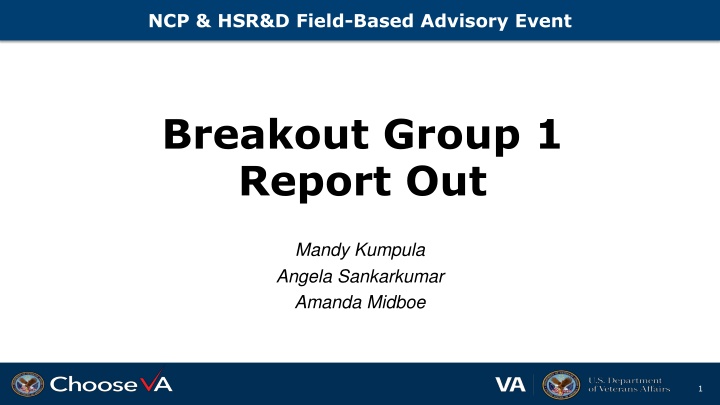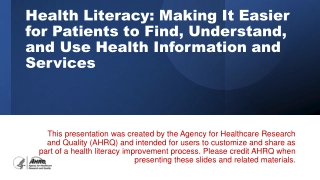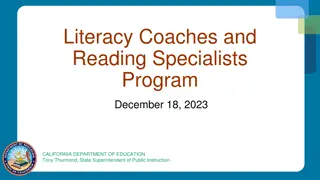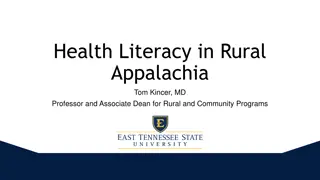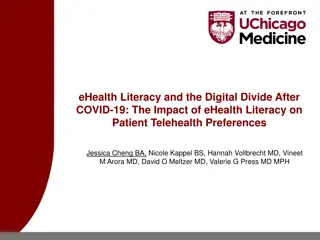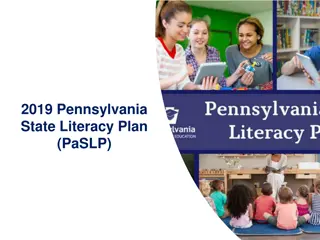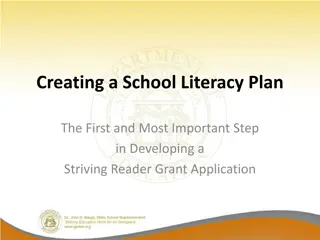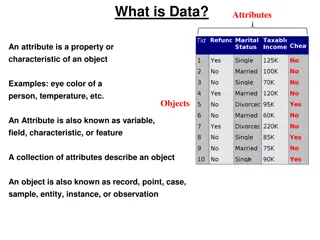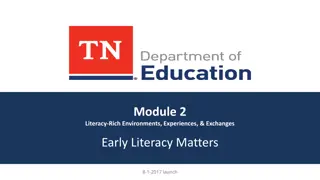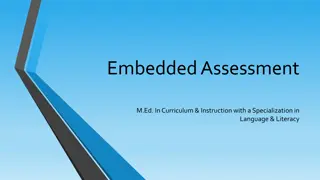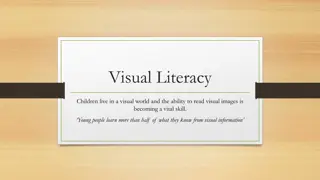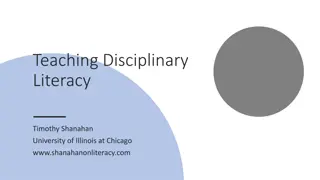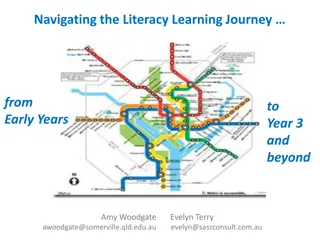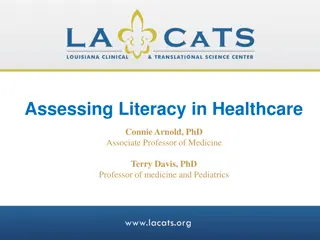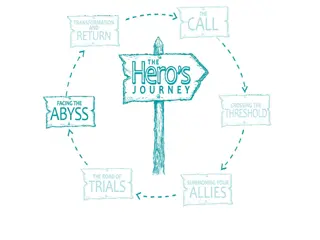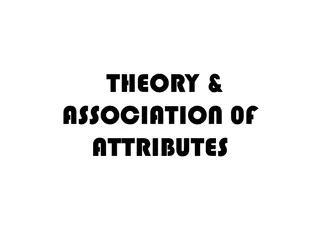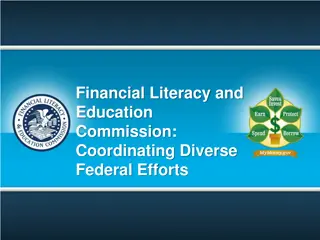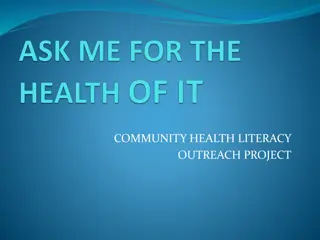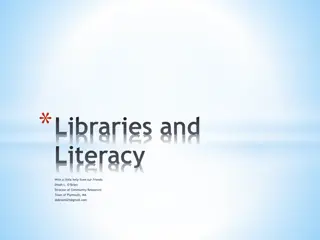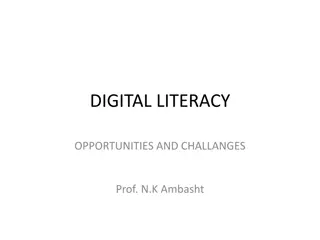Improving Organizational Health Literacy Attributes in VA
This report outlines strategies for improving organizational health literacy within the VA system, featuring key attributes identified by Breakout Group 1. Recommendations emphasize leadership involvement, workforce preparation, streamlined access to information, inclusive population engagement in education design, and clear communication of health plans and benefits.
Download Presentation

Please find below an Image/Link to download the presentation.
The content on the website is provided AS IS for your information and personal use only. It may not be sold, licensed, or shared on other websites without obtaining consent from the author.If you encounter any issues during the download, it is possible that the publisher has removed the file from their server.
You are allowed to download the files provided on this website for personal or commercial use, subject to the condition that they are used lawfully. All files are the property of their respective owners.
The content on the website is provided AS IS for your information and personal use only. It may not be sold, licensed, or shared on other websites without obtaining consent from the author.
E N D
Presentation Transcript
NCP & HSR&D Field-Based Advisory Event Breakout Group 1 Report Out Mandy Kumpula Angela Sankarkumar Amanda Midboe 1
NCP & HSR&D Field-Based Advisory Event Evaluation of Health Literacy and Patient Education 16 November 2022 Breakout Group 1 Report Out Predecisional / For Internal VA Use Only 2
Breakout Group 1: Organizational Processes Primary Question: What are the 3 most important attributes for improving organizational health literacy in VA?
Breakout Group 1 Leads Name Program Office Mandy Kumpula, PhD (Lead) EBP Program Evaluator Angela Sankarkumar, MPH (NCP Lead) National Center for Health Promotion and Disease Prevention (NCP) Amanda Midboe, PhD Principal Investigator, HSR&D John Atkinson, JD (PM) Office of Healthcare Transformation (OHT) 4
Breakout Group 1 Members Name Program Office Name Program Office Susan Woods Generated Health Angela Sankarkumar NCP Miho Tanaka PCS Mandy Kumpula EBP Anne Utech NFS Amanda Midboe HSR&D Danielle Thierry OIT John Atkinson OHT David Xander EES Sophia Califano NCP Jennifer Manuel OMHSP Laura Zimmerman HSR&D Storm Morgan ONS Mary Mangrum VEO Cindy Brach AHRQ Susan Mejia-Flores LGBTQ+ Health Jean Gurga Kansas VAMC Sherry Ball HSR&D Corey Gibbs Boise VAMC Jay Shiffler NCP Sue Raffa NCP Evelyn Sommers PCS 5
Recommendations-Top 5 attributes 1. Leadership Involvement and Support 2. Prepares the Workforce 3. Streamlined access to information, services and navigation 4. Includes populations in development and design of patient education 5. Clearly communicates health plan & benefit information 6
Leadership Involvement & Support 1. Leadership Involvement and Support Obtain VISN and facility leadership input about improving organizational health literacy Awareness campaign around organizational health literacy Provide summary report to the HOC and additional feedback on clinical stakeholders Potential metric: HL-10-HO assessment for VISN and facility leaders to assess how VHA is currently doing in the 10 attributes of organizational health literacy Potential metric: Element on Network Directors performance plan around organizational health literacy 7
Workforce Development 2. Workforce Development Develop nursing/clinician competencies around health literacy Environmental scan to determine current staff use and awareness around patient education and patient engagement tools to promote health literate, productive interactions Standardized plan and written framework for the development of patient education materials CPRS template on patient education to include Teach-Back and Joint Commission Requirements to gather greater documentation on use of Teach-Back Potential metric: % completion or use of health literacy/patient education competencies, health factors data of using Teach-Back in CPRS 8
Streamlined Access 3. Streamlined Access to Information, Services, and Navigation Enhance and raise awareness of existing tools and resources that help provide Veterans with information on navigating different resources within VA (example: Print Out Your VA Welcome Kit | Veterans Affairs) Review of functionalities with Patient Portal (My HealtheVet and Cerner My VA Health) and other digital technologies that support patient engagement and how Veterans and staff are aware of those different functionalities (e.g., Secure Messaging, After Visit Summary, Mobile apps) Lessons learned from redesign of va.gov website and how we continue to align resources along FAQs from Veterans around health care services and information Potential metric: Understanding of patient use of digital-facing patient technologies and staff understanding of these technologies to drive patient engagement 9
Includes Populations in Development and Design 4. Includes Populations in Development and Design of Patient Education Engage additional stakeholders from ILEAD (e.g., Designated Learning Officers) for input on this Develop a recruitment plan or strategy to increase the diversity of Veteran feedback Veteran journey map on patient education-identifying moments that matter where Veterans may need more education/information and ensuring health literate, productive interactions at that point in time Potential metric: Develop specific measurements to track Veteran recruitment strategies against 10
Clearly communicates health plan & benefit information 5. Clearly communications health plan & benefit information Opportunity with the PACT Act to think about how we can more clearly communicate health plan & benefit information. How can we increase engagement with VBA as that is often the first interaction with VA Veterans have as they are determining their eligibility and services? This is challenging to do in both the private sector and VA as it is hard to clearly communicate the cost of care, but we do have opportunities for this in VA! Important to get Veteran feedback on this element, which aligns with attribute #4 Potential metric: Consider evaluation plan elements within Section 121 of the VA Mission Act of 2018 11
Key Takeaways What should we continue doing? Utilizing lessons learned and ingredients from other initiatives, development of VA Welcome Kit and redesign of va.gov digital front door Continue creating content that aligns with Veteran questions and is easily understandable and actionable (e.g., streamlining content on va.gov websites) What should we implement? Recruitment strategy or plan around Veteran engagement in patient education Continue building awareness around organizational health literacy and opportunities, especially with input from facility and VISN leadership. What are the identified gaps where further research is needed? Understanding of organizational health literacy at different levels of VHA (National, VISN, Facility). Understanding of patient and provider use around different digital information technologies and opportunities for engagement. How can we effectively and correctly communicate cost of care and information around benefits and services? This is challenging to do in VA and the private sector, but we have more opportunities to do so in VA, especially with the PACT Act. 12
